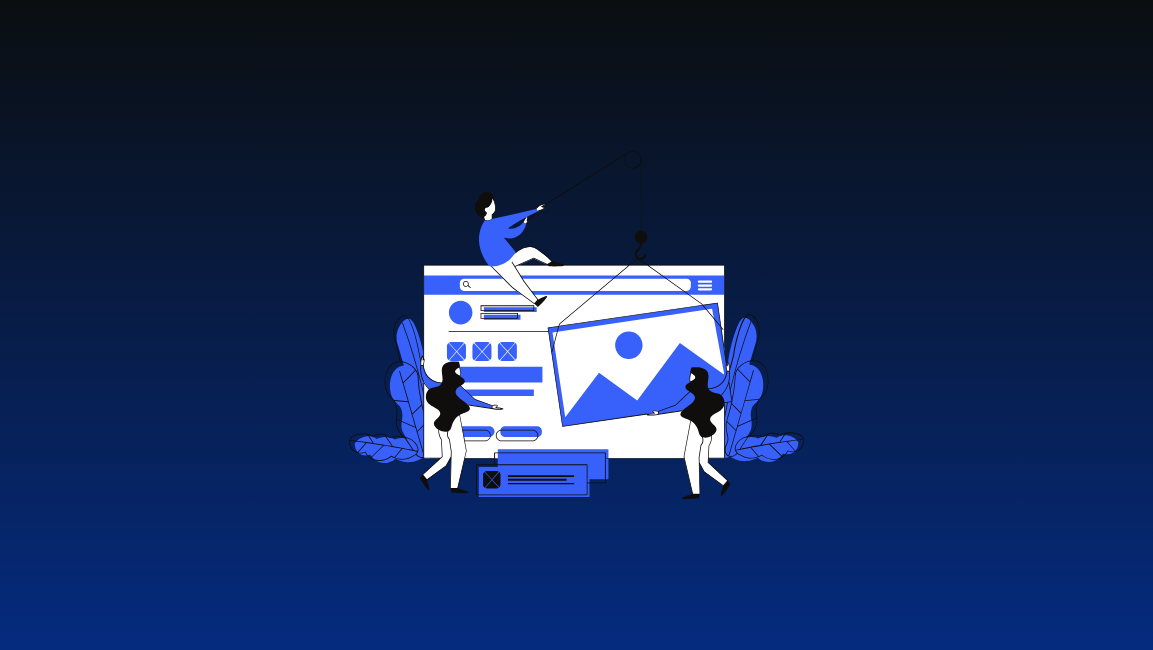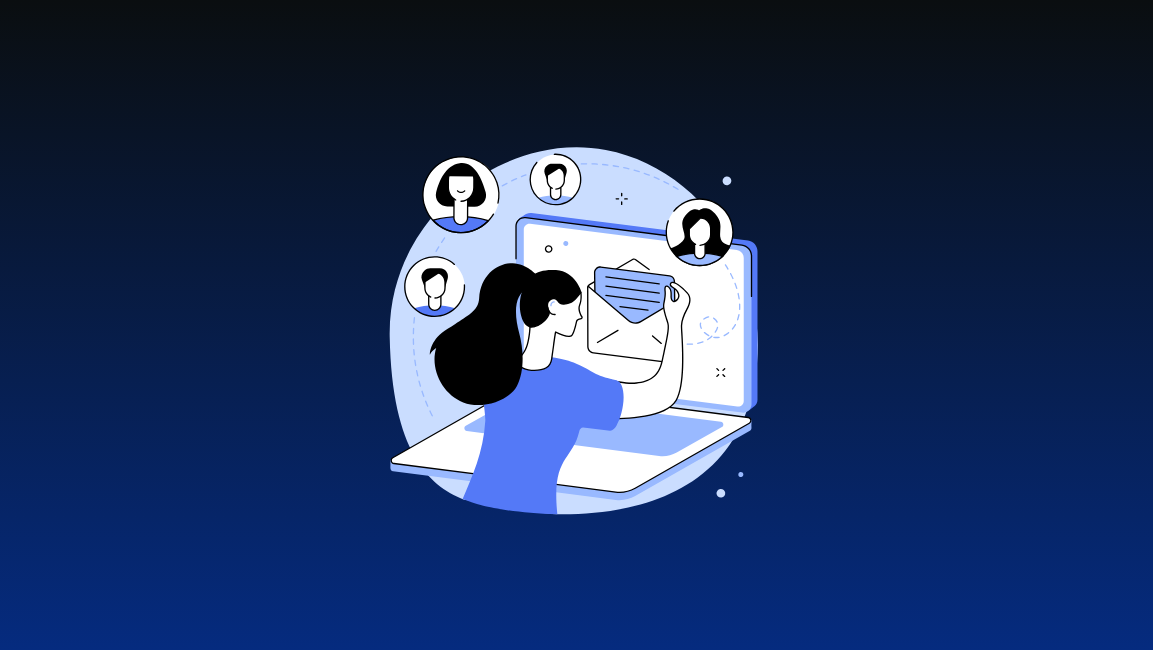It’s about not reinventing the wheel and implementing what works. Word-of-mouth already exists among your customer base. Turning it into a word-of-mouth marketing program that provides incentives for successful referrals? Now, that’s just smart.
TL;DR? Referral programs work. That’s why in this article, we’re going to share 20 of the best referral program examples so you can structure the best program for your company.
What is meant by referral program?
A referral program is a system that uses referral rewards to encourage past customers to invite friends to purchase a product or service to others in their network. The referral process is tracked using discount codes, coupons, or unique referral links. Referral programs are a key piece to marketing strategy. And, it works. More than 50% of current customers are likely to give a referral if offered a direct incentive and every new referral
What types of referral incentives can you offer in a referral campaign? Discount codes, store credit, gift cards, free products, and more.
What types of referral programs exist and what referral incentives can you offer in a referral campaign? Direct-to-consumer brands often encourage retention with discount codes, store credit, gift cards, and more. While B2B referrals are often encouraged by gift cards to other SaaS companies
What’s best and what’s not? That you can understand by reading about other companies’ successful referral programs. Check out these referral program examples.
Here are 20 Referral Program Ideas and Examples
1. Outway Socks

Outway Socks is one of the best referral programs to look at as an example. Why? Within 24 hours of launching their program, they smashed their first week’s goal of 1,000 signups. By the time that first week was over, they had over 5,000 active affiliates sharing their love of Outway to friends, family members, and social media channels.
Their goal was to drive revenue at a 3x ROI, so when the team realized that the program was cruising at a 5x ROI, they were thrilled.
One key to success? Rob Fraser, the founder of Outway Socks said,
“the nature of the program has a lot of virality to it. The fact that every new customer has the ability to share and refer means that the program basically runs itself. Our main job now is to stay out of the way.”
Key takeaways:
- When your product has natural word-of-mouth, adding a referral program throws fuel on the fire and drives new customer acquisition at a lower cost to acquire than paid advertising.
- Cash is an incredibly strong incentive to promote referrals and word-of-mouth.
2. Tabs Chocolate

While customers can be activated through referral programs, you can work with your best customers who refer the most business to create influencer partnerships.
Tabs Chocolate created an influencer marketing program that encourages influencers to refer those in their network in exchange for an incentive. They’re a great example of a referral program who targets influencers.
Their program saw great success–Driving an increase of 17% in influencer marketing revenue at a 9.8x return on investment.
Key takeaways:
- Referral programs can be used when you’re looking for new channels to grow revenue and don’t want to rely on paid advertising.
- Referral programs also apply to those with wide networks
3. Airbnb

The first phase of the Airbnb referral program was an unexpected success. They just created it and let it be; they never cared to promote it. In fact, many people working at Airbnb didn’t know such a program existed.
Soon Airbnb realized the referral program was bringing millions in revenue. That’s when they doubled down on creating a one-of-its-kind referral program.
Airbnb created Referral 2.0 around a decade ago for the then increasingly popular mobile users and, of course, web users. It allowed users to seamlessly import their Gmail contacts and send personalized emails to those contacts. In fact, and this is borderline illegal if you consider the talks around privacy these days, they also developed a program that tracked other contacts’ behavior to give existing users a list of contacts who are most likely to sign up with their referral link.

After building a considerably perfect referral program, they undid their previous mistake — they promoted the hell out of it. Of the many things they must have discovered during the whole Referral 2.0 journey, the most interesting one is the result they found after A/B testing the copy: Apparently, the altruistic message “give your friends $25 to travel” motivated more referrals than “invite your friends, get $25.”
Overall, this campaign drove 900% YOY growth for first-time bookings and 300% referral sign-ups.
Key takeaways:
- Always have a referral program. It’s perhaps the most cost-effective & high-value marketing machine for your business.
- Evaluate and better the program’s success by A/B testing.
Interesting fact: It took 5 full-time experts, 30,000 lines of code, and 3 months to develop Airbnb Referral 2.0. Today, you can have an even better referral program in less than a couple of minutes with Social Snowball (If you’re on Shopify). Sign up for a 14-day free trial.
4. Dropbox

Zooming from 100,000 users in September 2008 to 4,000,000 users in January 2010, Dropbox created a success story that’s talked about even today. Their clever yet simple referral program brought 35% of those users. It was a breakthrough, and hence it’s considered the epitome of referral marketing to this day.
The offering was quite simple: Invite a friend and get more free cloud storage. It permanently increased sign-ups by 60%.
Quite a story!
Key takeaways:
- Think beyond monetary incentives.
- Offer product-based perks. Not only will it increase word-of-mouth, but it will also increase brand loyalty.
5. Paypal

Guess who also believed in “steal like an artist”? People over at Dropbox! Before Dropbox made a success story powered by its referral program, Paypal did it & inspired Dropbox to create a program that encourages users to use the product as an incentive.
Of course, Paypal did it in their own way. They literally gave away free money (Side question: Do you think ‘Mr Beast’ also got inspired by this?). And it turned out to be a huge success! The Paypal Refer-A-Friend program boosted daily sign-ups by 7 to 10%, allowing them to cross the 100 million user mark in two years of launching.
Key Takeaways
- Offer an incentive that keeps the user attached to your brand. E.g., Giving a site-wide coupon.
6. Uber
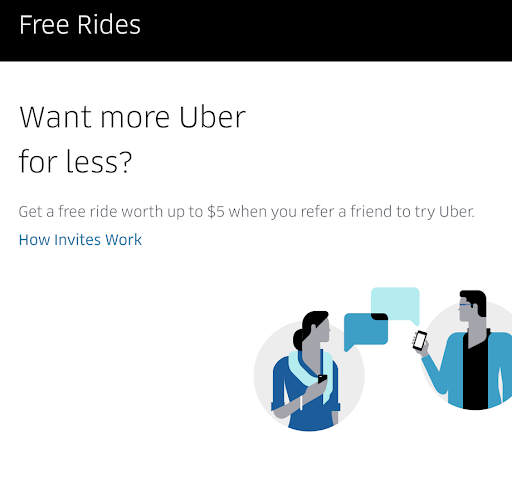
Uber’s product was revolutionary — It added a convenience layer to the way we transported. Indeed, people who used it in the initial days liked it; it was just a matter of getting more users before Uber became a mega-success.
Guess what helped them reach success faster? Their referral plan!
Uber got 12x ROI with their straightforward yet inciting referral program. They started with a $10 incentive (usable on rides) for both the referrer & the referee, and the program has been more or less the same throughout the years.
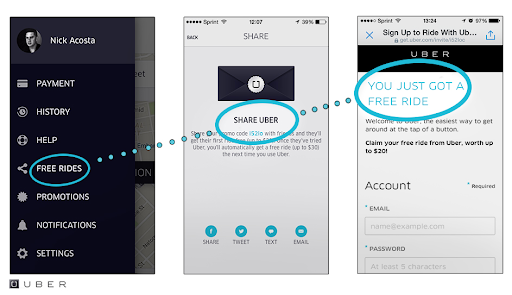
Another reason it was an instant success is how easy it was (& is) to access their referral program. Among the essential options on the sidebar of their app is one for sharing & getting free rides. Straightforward!
Key Takeaways
- Keep the button/link to the referral program at a frequently accessed place. Plus, make it frictionless to share.
7. Robinhood
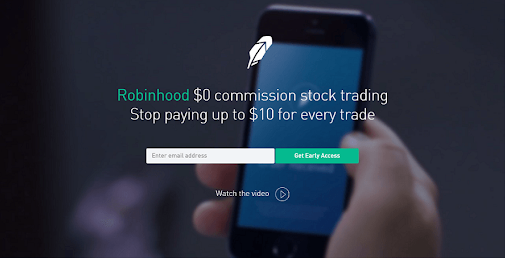
Robinhood’s current “Get a free stock” referral program works excellently. However, to be in a list of rare & inspiring referral program examples, some massive numbers must be involved.
Here’s one: 1 million warm leads pre-launch!
Robinhood started as a small startup with a great idea. When their product was almost perfect (for that time), they created a simple no-fluff pre-launch page & asked people their emails for early access to their about-to-launch revolutionary product.
Once registered, people received a Thank You email with their number on the waiting list. Below that number was a message that roughly motivated people to refer a friend to get priority access. And so it began…the exponential growth (or, as we like to call it, snowball effect) of Robinhood userbase pre-launch.
Key Takeaways
- Have a short, readable copy that explains the referral offer in seconds.
- Gamify the process.
- Use people’s fear of missing out (FOMO).
8. Evernote

With nearly 225 million users, Evernote is among the most popular cloud-based note-taking apps. Though the unicorn has been failing fast in the recent past, there’s something all businesses can learn from its successful referral program.
Evernote gained its first million users in nearly 14 months. In another two years, it reached a whopping 11 million users.

People over at Evernote noticed that the longer a user uses the platform, the better chances they pay for the premium plan. For example, nearly 8% of the free users upgraded to premium if they used the service for one year; comparatively, 23% upgraded to premium if they were on the platform for three years.
This meant people used the free plan for as long as possible and eventually upgraded when needed. In such a case, offering a cash reward for referring and bringing new users would mean the users will bring just the new users. Plus, because the user would earn only if the new user became a paying customer, it wouldn’t make for a compelling proposition.
Evernote’s point-based program killed two birds with one stone. 1. It helped attract new users + 2. More free users became premium users. Here’s how the program worked/works: If someone signs up with the user’s referral link/code, they get points. The points can later be used to upgrade to Evernote’s premium services like the Premium plan or Monthly boost.
This way, not only did people bring in new users, but they also got to try Evernote premium’s compelling features (leading to an upgrade to premium).
Key Takeaways
- Cash rewards aren’t the most effective referral incentives for all businesses.
- Notice user behavior to figure out your referral program incentives.
9. FreeAgent

FreeAgent is a cloud-based accounting software company. Small businesses pay a monthly fee (currently $20/month) to use its features.
What if the small businesses discovered they could literally pay $0 to use the service forever? They would snatch the opportunity!
FreeAgent provides them that opportunity…just, current users have to get ten other small businesses to use the platform. For every new user they bring, FreeAgent gives 10% off the bill to both the users (of course, until both parties pay for the platform). 10 users = 100% off (for the referrer).
What a smart referral program!
Key Takeaways
- Make an offer the users can’t refuse.
- If possible, give stackable rewards.
10. Tesla
Tesla is famously known for its $0 advertising budget. That’s thanks to the influence of Elon Musk and the brand loyalty Tesla has built over time. And, of course, there’s a referral program contributing to its success.
Even before Tesla launched its referral program, Tesla owners were promoting it via word of mouth. The referral program just incentivized the brand advocacy, which led people to promote it even further.
Their referral program incentives have changed a lot — they started with a double-sided $1000 Tesla credit as rewards; then they added MASSIVE prizes for the most successful referrers; the third iteration gave referrers a chance to win a tour to SpaceX. Currently, Tesla’s referral program is at its 10th iteration.
Overall, Tesla got a 40x ROI with its referral program, which is good enough to be on this list of referral programs examples.
Key Takeaways
- Build a brand so strong that people promote it even without getting anything in return. Then, add a referral program as a catalyst for word-of-mouth growth.
11. Harry’s

Today, Harry’s is billion-dollar shaving equipment and men’s personal care products company. But how did the success story of Harry’s start? With a referral program!
Harry’s launched a pre-launch referral program that incentivized getting people to join the pre-launch email list.
The incentives? There were 4 milestones depending on the number of referred friends that sign up.
- 5 friends = Free shaving cream
- 10 friends = Free razor
- 25 friends = Free premium razor
- 50 friends = Free shaving for a year
They ran Facebook ads and email blasts to get the initial pre-launch subscribers. And then the referral program did the job, or as we like to call it, the social snowball effect started.
Harry’s collected 100,000 emails in a week. Quite a success for a then-unknown company!
Key Takeaways
-
- Milestone referral program encourages people to invite more people than they would have in non-milestone one. (Only when 5 friends joined the list, the referrer got an incentive in Harry’s case. Now, if 8 friends join the list, the referrer will have an additional incentive to get two more to sign up).
12. Google Workspace
![Google Workspace referral program [Screenshot]](https://blog.socialsnowball.io/wp-content/uploads/2021/02/Capture.png)
Google Workspace is a collection of business apps and collaboration tools by Google.
In 2014, Google launched the referral program for the then “Google Apps for Work” and now “Google Workspace” to — as Cnet puts it — “spread the word on its business-related software.” The program paid $15 per user bought back then.
Since the program’s launch, the number of Google Workspace paid users grew from under 2 million to over 6 million. And though there are no statistics on the impact of the referral program on sales, from whatever little we learned, the Google Workspace referral program sure is a success.
Key Takeaways
-
- Referral programs are for businesses of all sizes (small or $2T companies) and all types (B2C or B2B).
Side note (unrelated): Google also has an employee referral program that helps them spread the word about their wonderful company culture and attract the best talent.
13. Dollar Shave Club

Dollar Shave Club is an iconic & inspirational ecommerce business example, especially for stores that sell subscriptions.
You probably know Dollar Shave Club for the viral video that surfaced during the initial days. What you might not know is that the video is not the only reason for their strong word-of-mouth marketing. According to their founder’s interview, 50,000 people a month refer a friend to Dollar Shave Club. This didn’t happen by fluke.
Dollar Shave Club strategically creates a delightful customer experience with their product and encourages users to join their referral program in exchange for up to $15 DSC store credit. They dedicate 50% of their email outreach to referrals and ask customers to refer their friends. Since customers are on a monthly subscription, a $15 store credit is a strong incentive to save money on their next order.
Key Takeaways
- DSC promotes its referral program from the first email itself. You should too.

14. Leesa

Most people buy mattresses once in 8 to 10 years and seek advice from friends and family before making a purchase. Leesa, an eCommerce mattress brand, runs a rewarding customer referral program to benefit from this buying behavior.
They offer $75 to their customers via PayPal (after referral finishes their trial period) and a 100-night sleep trial to their friends – making it extremely easy for customers to convince their friends to purchase from Leesa.
The referral program became so successful that Leesa witnessed 3,000 customers joining the referral program, driving 33% of the total sales.
Key Takeaways
- Understand user behavior to tailor-make your referral strategy.
- It will be easy for customers to convince their friends if you have an exciting offer for the friend (on top of a great offer for the referral, of course).
15. ASOS
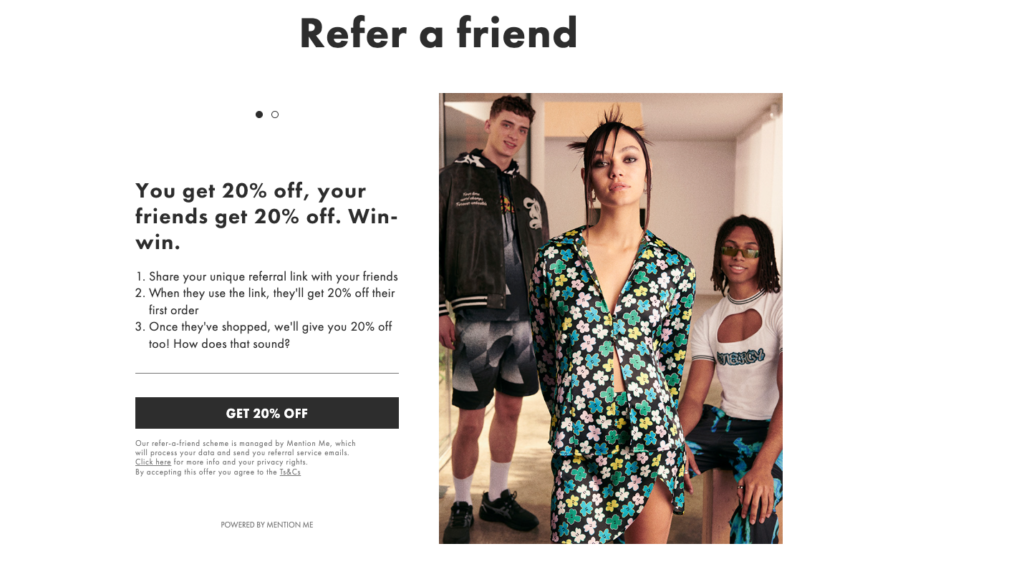
ASOS is a well-known fashion brand known for its modern marketing campaigns and engaging social media presence. They have a cult following of customers who miss no opportunity to buy from them, especially when there are discounts.
Encashing this opportunity, ASOS runs a two-sided referral program that gives 20% off to the referrer (existing customer) and 20% to the referee (new customer).
Key Takeaways
- Creating a two-sided reward system allows new customers to avail of discounts twice. Once when they’re a referee and secondly when they decide to become a referrer.
16. Dia & Co

Dia & Co is creating a safe space for plus-size women to buy the trendiest clothes in the market. As a part of their customer acquisition strategy, they’ve created a two-sided referral program for their customers. They reward existing customers $25 for referring friends, and referred customers receive a $25 discount + domino rewards on their future purchases.
Dia & Co used email marketing as their key marketing channel to prompt existing customers into joining their referral program. As a result, Dia & Co saw 40,000 customers share referral links, bringing 22 conversions a day during the first month itself.
Key Takeaways
- To the point communication and clearly defined CTA increases chances of conversion.

17. Dr. Squatch
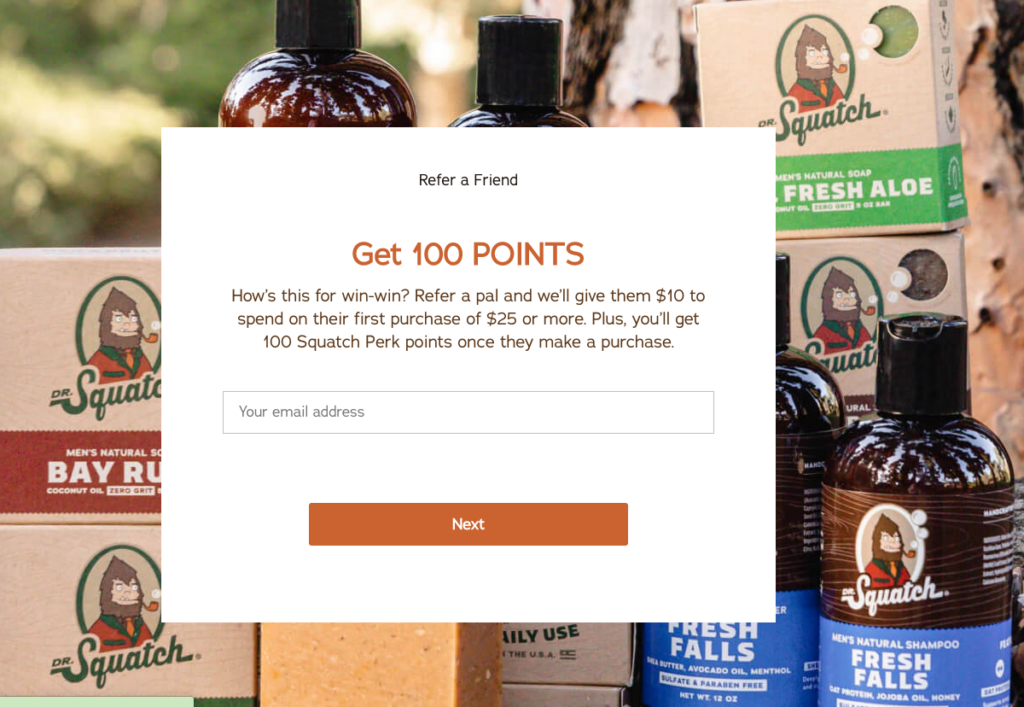
Dr. Squatch is a men’s soap brand. They built a referral program, and A/B tested it to determine the right offer strategy for their program. They created a double-sided referral offer and added two benefits to A/B test the offers: a $10 credit or a free soap bar. They concluded that customers found offers better than $10 credit.
Using insights from their A/B test, they created their current referral program that provides 100 points to customers & $10 discount to their referred customers. Customers can redeem their points to get direct discounts on their next purchase.
Key Takeaways
- Giving customers better offers increases referrals for your business. Gain customer insights by improvising offers and adjusting (A/B testing) your referral program accordingly.
18. Rothy’s
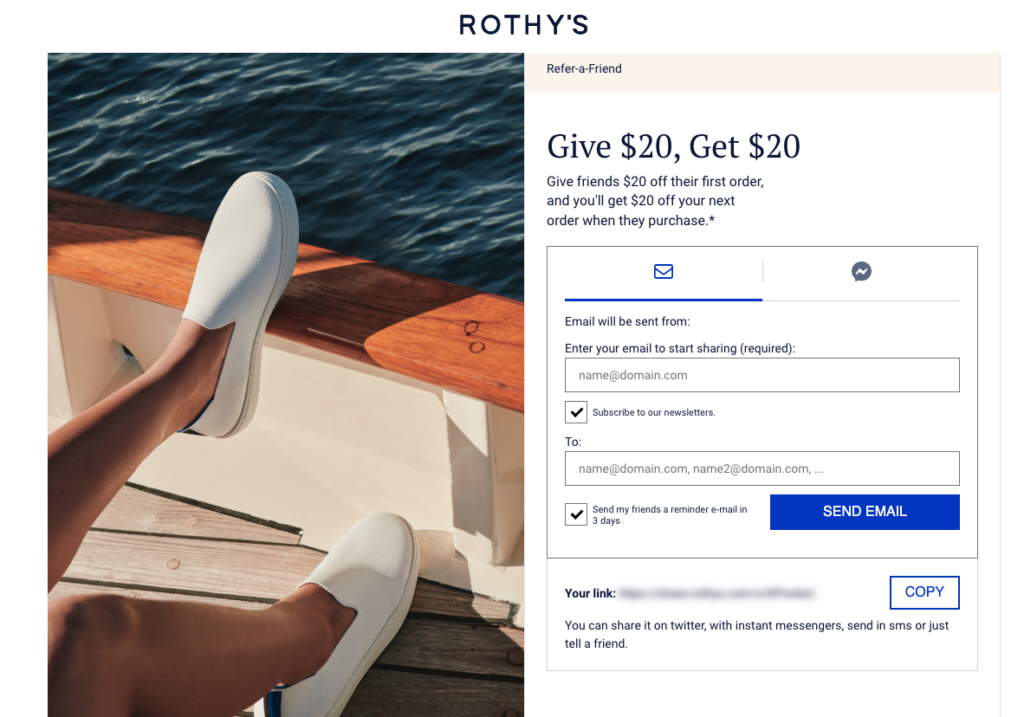
Rothy’s makes stylish flats, shoes, and handbags from 100% recycled plastic, and customers love them for it. The brand enjoys so much attention that word-of-mouth outweighs most of its marketing channels in getting customers.
They have a Facebook group with 23000+ customers bringing a lot of attention to the brand.
Rothy’s nurtures this community with a referral program that directly caters to the collective interest of their customers/followers – to grow the brand and increase its customer base. They offer a $20 direct discount to their customers and the friends they refer to buy from them.
Key Takeaways
- Referral programs help brands to turn their word-of-mouth marketing into a revenue-making engine.
19. T-mobile

T-mobile is a mobile carrier with who encourage customer loyalty with a referral marketing program to bring your friends, and earn up to $500 per year.
The average person already owns a smartphone and belongs to a phone carrier. If someone refers a friend onto t-mobile, it’s a win-win. T-mobile’s customer is rewarded, and a new customer is not only acquired, but won over from a competitive carrier.
Since most mobile carriers have similar functionality, a strong referral reward program can encourage loyal customers to share word-of-mouth referrals.
Key Takeaways
- Referral marketing programs can not only help with the first purchase of a direct-to-consumer brand, but can help encourage customers to switch from a competitor if referred from the best customers.
20. Amazon
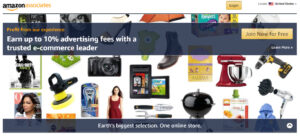
In the Amazon Affiliate program, members earn commission by sharing unique links and promoting them to their audiences, driving referral traffic back to Amazon.
The commission rates provided actually differ depending on the product category. For example, car parts differ widely from baby supplies.
This is an easy way to monetize sharing the Amazon brand, which is widely known by almost all consumers. Amazon however has strict guidelines when posting the links or the brand online, and associates must follow these guidelines.
Key Takeaways
- If you have differing product categories or margins, create a referral program that leverages segmentation and protects your revenue margins.
- Creating strict guidelines can help protect your brand against negative sentiment.
Inspired? Here’s How You Can Launch Your Own Customer Referral Program:
As I mentioned in the Airbnb referral program example, setting up your own referral program these days is straightforward. Just follow these three steps:
How to Create a Referral Program
A referral program app/software will help you create a referral program. Once set up, your customers can “refer a friend” and get a commission for every successful sale they bring in. What’s more, the software will also track all the KPIs — total revenue, revenue per referrer, AOV, etc. — to keep you updated on the success of your referral marketing efforts.
What is the Best Referral Reward for Incentive?
As you saw throughout the articles, you can give different types of commissions: store rewards, cash, discounts, premium service, etc. Depending on your business, set up the reward structure that you think will best work for your referral program and for your margins.
For most product-selling ecommerce stores, cash rewards work the best. We suggest you set a 10-20% of the revenue or a fixed cash reward per sale for maximum success.
You can also set up tiered rewards. For example, offer a discount code for the first purchases made by 5 referrals, and then begin to offer cash commission for new business referrals.
What is the Best Way to Get a Referral?
If you’re using any referral/affiliate app other than Social Snowball, you’ll need to let your customers know about the referral program. Otherwise, most customers won’t even know they can refer & earn and hence won’t promote your product or service.
When you have a sign-up landing page on your site that touts the benefits of your referral program, it’s easy for happy customers to find your program and sign-up themselves. Or, you can promote your sign-up landing page across social media like Facebook, Instagram or Linkedin.

You can also automatically add new customers to your referral program after they make a purchase. This is an easy way to grow your program and turn your customers into an affiliate network.
How? Social Snowball shows customers their referral link and personalized discount code on the “Thank you for the purchase” page every time they checkout. Not only does it spread awareness about the referral program, but it also increases the number of referrers because most customers have a reason to buy from you, and they can share the same with their friends and family when it’s fresh in their minds.
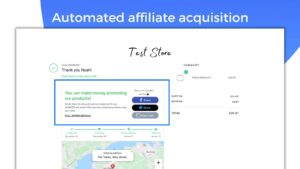
To promote the program, try running an email campaign about it, mentioning it at the bottom of each newsletter, doing SMS marketing, adding a CTA at the end of your blogs/help resources, and showing the ‘refer a friend’ button at commonly-seen places (like Uber did with its referral program), etc. Social Snowball has email and SMS templates that you can use for managing your referral program.
Final Words
Drawing inspiration from already successful ideas and analyzing why those ideas became successful is the quickest way to start from a solid & uplifted foundation. It’s true for everything, including when you are about to build a referral program.
Don’t reinvent the wheel. Implement what works. And if you are on Shopify, install Social Snowball to build your referral and affiliate program in a jiffy.

